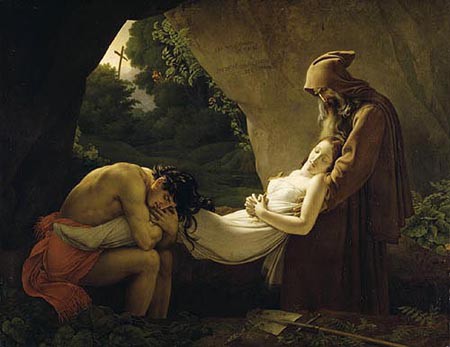The novel Atala or the love of two savages in the wilderness by Chateaubriand gave Girodet the subject for one of his most popular paintings. Set in primitive America of the 17th century, Atala is the tragic story of a young Christian metisse who falls madly in love with Chactas, an 'Indian' whom she has saved from a death sentence. Taken in by a missionary, Father Aubry, after a long 'walkabout', the young lovers however cannot live out their passsion. Trapped by the vow made to her mother to dedicate herself to religion, Atala chooses suicide in order to avoid succumbing to her passion, despite Chactas' willingness to convert so as to be able to marry her.
Presented at the Salon of 1808, the painting is evidence of the renewal of religion in France, ever since it had been re-introduced by the Concordat. And Chateaubriand himself was to be influential in this return of Christian religion with his book, Génie du christianisme (The Spirit of Christianity). Indeed, Chateaubriand was include the story of Atala (intially published separately in 1801) at the end of the third part of his work on Christianity, thereby aiming to illustrate the “Harmonies of Christian religion with the scenes of nature and the passions of the human heart”.
Girodet took full advantage of the romance of the subject by setting the dramatic denouement. Here Chactas and Father Aubry carry the body of Atala out for burial in the tomb which they have just dug at the entrance to a cave in the wilderness. On the cavewall the painter has reproduced the line adapted from the Book Job by Chateaubriand : “I have faded like a flower, I have withered like the grass of the field”.
Whilst it is true that, as a good pupil of David's, Girodet pays his respects to the Neoclassical style of the time, notably in the 'frieze' composition and the precise nature of the draughtsmanship, he nevertheless distances himself from his teacher in the sentimental quality which he gives to the piece, hugely different from the practice of history painting with its baggage of moral and political symbolism. Indeed, the work is strongly anchored in the grand pietà tradition of Christian iconography. But the religious is strongly tinged with morbid eroticism. As the very model of virginal purity in her white shroud, the chaste Atala (whose idealised beauty sets her apart from the twilight around her) remains deeply sensual. The poignant sadness of Chactas clasping the lifeless body of his beloved and the sympathetic gravitas of Father Aubry complete this composition already a long way down the road of Romanticism.
Karine Huguenaud (trans. P.H.)
September 2005
"The entombment of Atala" also called "Atala’s funeral"
Artist(s) : GIRODET DE ROUCY-TRIOSON Anne-Louis

- Date :
- 1808
- Technique :
- oil on canvas
- Dimensions :
- H = 2.07 m, L = 2.67 m
- Place held :
- Paris, Musée du Louvre

